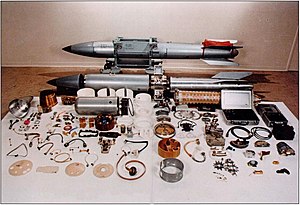

This article includes a list of references, related reading, or external links, but its sources remain unclear because it lacks inline citations. Please help improve this article by introducing more precise citations. (February 2014) (Learn how and when to remove this message)
|

Awarhead is the section of a device that contains the explosive agent or toxic (biological, chemical, or nuclear) material that is delivered by a missile, rocket, torpedo, or bomb.
Types of warheads include:
Often, a biological or chemical warhead will use an explosive charge for rapid dispersal.
Explosive warheads contain detonators to trigger the explosion.
Types of detonators include:
| Type | Definition |
|---|---|
| Contact | When the warhead makes physical contact with the target, the explosive is detonated. Sometimes combined with a delay, to detonate a specific amount of time after contact. |
| Proximity | Using radar, sonar, a magnetic sensor, or a laser, the warhead is detonated when the target is within a specified distance. It is often coupled with directional explosion control system that ensures that the explosion sends the fragmentation primarily towards the target that triggered it. |
| Timed | Warhead is detonated after a specific amount of time. |
| Altitude | Warhead is detonated once it falls to a specified altitude, usually in an air burst. |
| Remote | Remotely detonated via signal from operator. (Not normally used for warheads except for self-destruction) |
| Combined | Any combination of the above. |